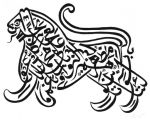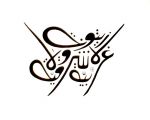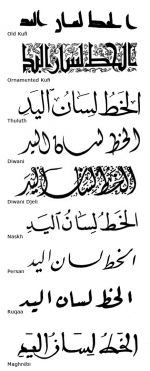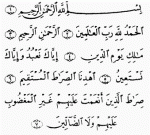Arabic writing
The first Arabic writing is conventionally said to emerge in the first century of hidjra the 7th a.d. By that time the Arabic alphabet had virtually formed but not completely. The archaic writing was rather primitive and had been used in Arabia since the Islamic state formed there at the time of Muhhamed anf first califs. One can already notice traits peculiar to classical Arabic writing in that proto-Arabian writing, the same letter could correlate with three or four phoneme that later differentiated between each other with additional symbols: over and under lower-case marks in orm of diacritical points. Later symbols of "shadda or tashtit" were brought in to signify consonants. Wovelization came into being later. The form of letters was taken from former Semitic handwriting. Orthography emerged later, the necessity of text wovelization ripened only by the end of the 7th century. Early Arabic writing virtually imitated the Syrian one. Unfortunately it`s difficult to date the emergence of the Arabic alphabet exactly, but all evidences tell us about the foreislamic period of its origin.
Differential characteristics
Islamic Calligraphy is a sphere of decorative art that could be either individual or arts and crafts, important cultural symbol of Islam, that accumulated cultural elements of foreislamic heritage.
The convention of artistic language peculiar to calligraphy that as a whole implies even deforming into an abstract image with the origin meaning missing in terms of apothematic tradition enables us to correlate Islamic writing with the sphere of ornament.
Without any context one can speak about two functions of calligraphy: decorative and spiritually mystical.
In Arabic calligraphy there is "hatt or hutut". Originally Islamic calligraphy emerged on the basis of Qur’an coping that is said to be Allah’s creation. In these terms the written word has got a sacred meaning.
Two main types of Arabic writing are known in the earlier days of Islam: monumental and cursive. Monumental writing is based on straights and has equability and monumentalism.
Cursive writing applies to be used in vernacular writings and later became a basis for "nash" handwriting.
So there are several questions about the character of the first calligraphic handwriting and the character of its beginning and where exactly it appeared and they could all have different answers. As earlier archaic handwriting also has several determinations
Unfortunally, we have only hypothesis. For a long time researchers said that kufi was the first Arabic handwriting and all the following styles of calligraphy emerged from this as monumental as cursive.
But the two tendencies developed in parallel and now it`s an incontestable fact that cursive writing didn`t emerge from monumental and such like transformation couldn’t happen at all.
Nevertheless even now the term "monumental handwriting" has no single definition.
According to the analysis of the given examples taken from Xertsfeld`s archives one should claim that:
Monumental and cursive handwritings, originally forecursive and fore monumental, are similar.
Many consider "monumental handwriting" as being used only on solid materials – on metals or stones. According to this fact large scale and quality and sacral functions,value of the object play a profound role. As a rule these are monuments of architecture: mosques, stellas and coins.
In this context "kufi" used on papyrus (that is a soft material) opposed monumental kufi meanwhile the usual handwriting of the Qur’an is on the line between the first and the second one.
In numismatics there was a combination of cursive and monumental styles .
Only one thing is clear that the monumental style combines angular elements and static forms meanwhile cursive that is exclusively a handwritten one due to being written ceaselessly, has peculiar forms of being suppressed and round elements. The latter one is mostly designed for widespread use.
Addressing the history of Arabic writing and the time of calligraphy uprising one should research Islamic and European written sources
Ibn-an-Nadim`s sources outlines mentions of four prime writings : “makki” “madani” “basri” “kufi”
Names of which emanate from their places of origin - Makka, Al madina, Basra, Kufa.
It`s remarkable that only Makka has an inclination of alifa to right beneath of the bottom, arching lines of letters alif(i), lam (j) and lam-alif (ﻻ ), high verticals of ma (ط ) and caf (ک ), and virtually slight inclination of the writing to the right. Madan writing has three types: mudavvar, peculiar round loops of letters vav (ﻭ), fa (ﻑ ), kaf (ﻕ ),
Mim (ﻡ ), ain (ع ), gain (غ ) and ha (ﻩ ).
As for the kufi writing there is confusion. Research including, Aid Se Arif, referring to Arabic research, determine some earlier monumental type of combination, hira-kufaic. Peculiar traits of the handwriting are size, short and thick lines, angular forms and its correlation with quadrate print.
It`s accustomed to determine six major types of handwritigs.
These are:
kufi – الكوفي – kufi city
Suls – الثلث –«one third»
Nash– النسخ – «copy»
Tal`ik– التعليق –it`s named as farcy «language of commentation»
Diivany ا-لديواني –«office style»
Rica – الرقعة – «low style»
Masters of arabic callygraphy:
The first outstanding master was Abu Ali ibn Mkla (272y.city of Hidjri 328\940y. )
Abul –el –Hasan Ali b.Hilal – born in 422 y. City of hidjri\1022y. His nickname – "Ibn Al Bavar" - son of a butler, literally "son of who opens the door". Follower of Ibn al Bavvaba
Yacut al-Musta` Simi – died in 698y. City of Hidjri\1298 – the last follower of Ibn al Bavvaba
According to legends the first master of calligraphy: Halid Abi Hayyaz is a legendary person. He lived in the 7th century. It`s difficult to appraise his achievements as there are no sources and monuments of him.
Then in the 7th century penman Gotba invented 4 calligraphic styles: mekkanian, basrian, kufian, medinian named according to their approximate places of origin. But this has not been confirmed academically.
There is a version that the legend about the spreading of the four styles came into being due to ideological clashes between different denominations inside the Islamic community
Some think that an outstanding penman was the son-in-law of Muhhamed Ali but still even here there is no paleographical conformation.
Even at the times of Abbasid califs due to centralization and confirmation of the calif power caste of penmen (huttab) that were secretaries and administrators extended.
In the 10th century Islamic world, cultural sovereignty and calligraphy was archived being a cultural symbol praised Islamic expansion. Sacral kufi gave its place to nasha and other cursive handwritings illustrating a changing of era. "Era of outstanding penmen" came into being - Ibn li,Muk,Ibn al-Bavvaba,Yacuta al-Musta`simi.
Back to listCalligraphy is the art of both ideal writing and an ideal soul.







